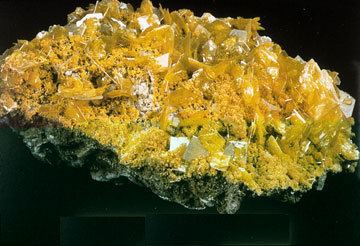 | ||
In crystallography, the tetragonal crystal system is one of the 7 crystal systems. Tetragonal crystal lattices result from stretching a cubic lattice along one of its lattice vectors, so that the cube becomes a rectangular prism with a square base (a by a) and height (c, which is different from a).
Contents
Two-dimensional
There is only one tetragonal Bravais lattice in two dimensions: the square lattice.
Three-dimensional
There are two tetragonal Bravais lattices: the simple tetragonal (from stretching the simple-cubic lattice) and the centered tetragonal (from stretching either the face-centered or the body-centered cubic lattice). One might suppose stretching face-centered cubic would result in face-centered tetragonal, but face-centered tetragonal is equivalent to body-centered tetragonal, BCT (with a smaller lattice spacing). BCT is considered more fundamental, so that is the standard terminology.
Crystal classes
The point groups that fall under this crystal system are listed below, followed by their representations in international notation, Schoenflies notation, orbifold notation, Coxeter notation and mineral examples.
